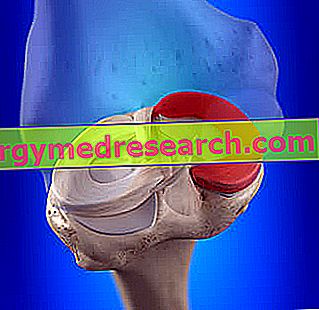Generality
Gastroesophageal reflux is the abnormal ascent into the esophagus of the acid contents of the stomach.
This phenomenon can be sporadic or chronic; when it takes on the contours of a chronic problem, doctors more accurately talk about gastroesophageal reflux disease .
A chronic cause of gastroesophageal reflux is the malfunction of the cardia which is the valve located between the esophageal and the stomach, which prevents food from rising in the stomach.

Conditions that favor the onset of gastroesophageal reflux disease include obesity, cigarette smoking, alcoholism, pregnancy, hiatal hernia, asthma, excessive consumption of fatty foods, and intake constant of certain medicines (eg anxiolytics, anticholinergics, etc.), stress and gastroparesis.
The typical symptoms of gastroesophageal reflux disease are: heartburn, chronic acid regurgitation, sore throat, hoarseness, chest pain, dysphagia, halitosis, cough and wheezing.
In general, the diagnosis of this widespread condition is based on physical examination and medical history. However, in some circumstances, more thorough tests are fundamental, such as gastroscopy and / or 24-hour esophageal pH-metrics.
As a rule, therapy is pharmacological; however, if the drugs do not work, there is the possibility of resorting to surgical treatments.
A healthy lifestyle (eg: not smoking or not eating too much fat) helps control symptoms.
Brief anatomical recall of esophagus and stomach
ESOPHAGUS
The esophagus is the cylindrical organ of the digestive system that directs the ingested food to the level of the mouth towards the stomach .
About 25-30 centimeters long and about 2-3 centimeters wide, the esophagus begins at the level of the pharynx and ends at the level of the cardia (or lower esophageal sphincter ), that is the valve that, thanks to its particular muscular structure, regulates the passage of food in the stomach.
STOMACH
The stomach is the organ of the digestive system, shaped like an elongated sac, which collects the food coming from the esophagus and in which the digestion of proteins and carbohydrates takes place .
About 25 centimeters long and protected by the peritoneum, the stomach begins at the aforementioned cardias and ends at the level of the pyloric sphincter, which is the valve that regulates the entrance of food from the same stomach to the small intestine (or small intestine ).
The stomach has, inside, a typical acidic environment, fundamental for the correct fulfillment of its digestive functions. To create this characteristic acidic environment are the so-called acidic gastric juices, secreted by specific cells of the stomach mucous membrane (or gastric mucosa).

What is gastroesophageal reflux?
Gastroesophageal reflux, or gastric reflux, is the phenomenon of rising in the esophagus of the stomach contents; content that has a typical acidic nature.
The phenomenon of gastroesophageal reflux sporadically affects many people, often without their knowledge and without a pathological origin.
When does gastroesophageal reflux become a disease?
Gastroesophageal reflux becomes a disease when it abandons the appearance of a sporadic phenomenon and assumes the contours of a chronic disorder, the repetition of which leads to the appearance of symptoms and signs, sometimes very annoying.
Doctors define the chronicization of gastroesophageal reflux as " gastroesophageal reflux disease " or " gastric reflux disease ".
To define gastroesophageal reflux disease there are also two abbreviations, one Italian and one English. The Italian abbreviation is GORD, which stands for Gastro- Esophageal Reflux Disease, while the English abbreviation is GERD, which stands for Gastro - Esophageal Reflux Disease .
Epidemiology
According to statistics, in the so-called Western World, the phenomenon of gastroesophageal reflux is responsible for symptoms on a weekly basis in at least 20-30% of the general population.
Age-related studies of most patients with gastroesophageal reflux disease have shown that it is more common among the elderly; from these same studies it has also emerged that the number of people with symptoms attributable to gastroesophageal reflux increases progressively from the age of 40.
There is no evidence to show a greater tendency on the part of men or women to suffer from gastroesophageal reflux disease; therefore, it is impossible to say that the male gender is more affected than the female gender, and vice versa.
According to some surveys on a global scale, the phenomenon of gastroesophageal reflux would produce symptoms with a weekly / daily cadence in 5-7% of the total population.
Gastroesophageal reflux disease in numbers:
- In the United States, 20% of the population complains of symptoms attributable to gastroesophageal reflux disease at least once a week, and 7% at least once a day;
- In the countries of the so-called Western world, 50% of gastroesophageal reflux disease diagnoses involve people aged between 45 and 64 years.
- In the United States, about 1% of people diagnosed with gastroesophageal reflux disease also suffer from Barrett's esophagus, a serious complication of the aforementioned disease.
- In the United States, there are about 68 million annual drug prescriptions for the treatment of gastroesophageal reflux disease.
- In 2004, in the United States, 1, 150 of total deaths were directly linked to the phenomenon of gastroesophageal reflux disease.
Causes
When it is chronic (therefore in gastroesophageal reflux disease), the phenomenon of gastric reflux is due to a malfunction of the cardia (or lower esophageal sphincter).
Medical and scientific studies have shown that, generally speaking, a combination of factors, including:
- Obesity and overweight . The excessive presence of fat in the abdominal area leads to abnormal pressure on the stomach, in particular at the level of the cardia. Due to this anomalous pressure, the cardias weaken from the muscular point of view and this determines their functioning.
- The hiatal hernia . It is the protrusion of the stomach through the so-called esophageal diaphragmatic hiatus, which is the hole in the diaphragm into which the esophagus normally enters.
The doctors have not yet identified the precise causes of the hiatal hernia, however they have noticed that the subjects most at risk of developing this condition are: the victims of a strong abdominal trauma, the individuals with a congenital anomaly of the esophageal hiatus, the people obese or overweight, and chronic cough patients.
- Cigarette smoking, the abuse of alcohol, the intake of large quantities of coffee, and the great consumption of chocolate . According to the doctors, all these factors would cause excessive relaxation of the cardias' muscles. Excessive relaxation of the cardias' muscles jeopardizes the ability of the latter to close properly and thus prevent the ascent of gastric contents.
- Asthma . It is an obstructive disease of the respiratory system, in particular of bronchi and bronchioles, with chronic characteristics.
- Zollinger-Ellison syndrome . It is a rare disease characterized by the appearance of gastrinomas in the pancreas or duodenum. Gastrinomas are malignant tumors that cause gastrin hypersecretion.
The presence of massive quantities of gastrin elevates the acidity of the stomach in an extremely dangerous way, giving rise to continuous peptic ulcers, severe abdominal pain, diarrhea, etc.
- Scleroderma (or systemic sclerosis ). It is a chronic inflammatory disease of the connective tissue, which mainly affects the skin, but can also extend to the blood vessels, to some internal organs (heart, lungs etc.) and to the nervous system (nerves in particular).
- Pregnancy . In pregnant women, the tendency to develop gastroesophageal reflux disease would be related to changes in hormonal levels, typical of the state of pregnancy, and to the compression exerted by the expanding fetus on the stomach and esophagus.
- Excessive consumption of fatty foods (eg fried). When the stomach is filled with large amounts of hydrochloric acid, such as during the digestion of very fatty meals, it is easier to experience phenomena of gastric reflux. Using a comparison, something very similar to when too much water is poured into a container: in such circumstances, the risk of spilled liquid escaping, for example at the slightest movement, becomes elevated.
- Gastroparesis . It is the partial paralysis of the stomach, with consequent prolonged permanence, at the gastric level, of the ingested food.
Therefore, the stomach of people suffering from gastroparesis does not become empty at the same speed as healthy people.
- Hypercalcemia . It is the medical condition characterized by an abnormal increase in the concentration of calcium in the blood.
- Stress .
- The constant intake of certain types of drugs . Among the medicines incriminated to have a favoring role on the onset of gastroesophageal reflux disease, we note: anticholinergics (for the treatment of overactive bladder or motion sickness), bronchodilators (for the treatment of asthma), calcium antagonists (for the treatment of hypertension), dopaminergics (for the treatment of Parkinson's disease), progestin (a contraceptive also useful in the treatment of menstrual irregularity), nitrates (for the treatment of angina pectoris), the anxiolytics (for the treatment of anxiety and insomnia) and tricyclic antidepressants (for the treatment of depression).
The clinical significance of sporadic events of gastroesophageal reflux is the subject of numerous debates.
To make the experts discuss is the fact that, in some circumstances, sporadic gastroesophageal reflux is the prelude to gastroesophageal reflux disease, while in other situations it is an isolated phenomenon, which has no particular follow-up.
Who is more at risk of gastroesophageal reflux disease?
The subjects most at risk of developing gastroesophageal reflux disease are:
- Obese and overweight people;
- Pregnant women;
- People with hiatal hernia, scleroderma, gastroparesis or Zollinger-Ellison syndrome;
- Asthma sufferers;
- Individuals who take the offending drugs contribute, if taken consistently, to the development of the disease (anticholinergics, anxiolytics, calcium channel blockers, nitrates, tricyclic antidepressants, bronchodilators, etc.);
- Smokers and large consumers of alcohol, coffee or chocolate.
Symptoms and complications
The inner wall of the stomach and that of the esophagus are extremely different: unlike the second, in fact, the first has a layer of cells specifically dedicated to the production of mucus, with a protective action against acidic gastric juices, which have a high harmful and irritating power.
This means that, while the stomach bears very well the acidic environment that it produces inside it, the esophagus does not have this ability and is deeply affected by the rise of acid juices from the underlying compartment.
This fragility of the esophagus, with respect to the acid content coming from the stomach, is the reason why gastroesophageal reflux, especially when it is continuous and repetitive, is responsible for a very specific symptomatology.
Symptoms of gastroesophageal reflux disease
Going into details, the typical symptoms and signs of gastroesophageal reflux disease are:
- Stomach ache. As a rule, patients complain of this sensation just below the chest, ie in a retrosternal position; in some individuals, however, it is spread to the throat and / or behind the shoulder blades.
In most people with GERD, heartburn tends to intensify after meals, when they bend (for example, to pick up an object) and when they lie down.
- Frequent regurgitations of acid gastric contents up to the throat and, in the most serious cases, up to the mouth. These phenomena are often responsible for an unpleasant and acid taste on the back of the mouth;
- Sore throat and changes in tone of voice (hoarseness). They arise when the gastric juices of regurgitations repeatedly reach the trachea, pharynx and vocal cords, causing irritation and inflammation;
- Difficulty in swallowing (dysphagia);
- Pain during swallowing;
- Hiccup;
- laryngospasm;
- Chest pain, to be precise in the cardial area (ie where the cardia resides)
- Halitosis;
- Persistent cough and / or wheezing. These are two symptoms that tend to get worse at night;
- Sense of stomach swelling.

Complications
In the long run, severe gastroesophageal reflux disease or gastroesophageal reflux disease that has not been adequately treated can lead to complications, such as:
- Esophageal ulcers . Esophageal ulcers are lesions or wounds on the mucous membrane of the esophagus. In gastroesophageal reflux disease, it is the acidic contents of the stomach that repeatedly cause it to rise up into the esophagus.
Esophageal ulcers are bloody and often painful; furthermore, they make swallowing difficult.
- Esophageal stenosis . In medicine, the term "stenosis" indicates an unnatural narrowing of a blood vessel, a hollow organ, etc.
Esophageal stenosis, therefore, is the unnatural narrowing of the esophagus.
In gastroesophageal reflux disease, it is caused by the huge amount of scar tissue, formed where there were esophageal ulcers: this tissue, in fact, occupies such a volume that, in some of its sections, the esophagus undergoes a narrowing.
Esophageal stricture makes swallowing difficult and painful.
- Barrett 's esophagus . It is the medical condition characterized by a change in the typical inner lining of the lower portion of the esophagus, which takes on the characteristics of that present at the level of the duodenum . In other words, in those suffering from Barrett's esophagus, the lower part of the esophagus has changed its inner wall into the same wall at the level of the first intestinal tract.
In gastroesophageal reflux disease, the presence of Barrett's esophagus does not generally add further symptoms, but increases the risk of esophageal cancer, a malignant tumor.
Based on the most reliable statistical surveys, one in every 10 with gastroesophageal reflux disease is a victim of Barrett's esophagus and an individual every 10-20 with Barrett's esophagus gets cancer of the esophagus within 10-20 years.
Therapeutic remedies for complications in brief: | |
In the presence of oesophageal ulcers → | The most practiced therapy consists in the administration of so-called proton pump inhibitors (IPP), which have the task of reducing the number of episodes of gastroesophageal reflux. |
In case of esophageal stenosis → | The most common treatment consists of an esophageal stent surgery. |
In the presence of Barrett's esophagus → | Doctors recommend surveillance of the condition, through a periodic endoscopy of the esophageal tract (esophagus-gastroduodenoscopy). In this way, there is a greater chance of detecting any malignant formation when it is still in its infancy. |
When should I go to the doctor?
According to experts, it is a good idea for an individual to contact, without hesitation, their own doctor or go to the nearest hospital, if they feel heartburn in a retrosternal position, chest pain, wheezing, etc. It will then be the duty of the doctor or hospital staff to establish the exact nature of the symptoms in progress.
This care is a must, as the typical symptomatological picture of gastroesophageal reflux disease also characterizes other diseases, some of which are real emergencies (eg heart attack) and require immediate therapeutic intervention.
When an individual with a diagnosis of GERD should contact the doctor?
People who are following a specific therapy for gastroesophageal reflux disease should contact their treating physician, when the treatment plan provided for them is not very effective.
Such foresight is important, as - as will be recalled - the failure to treat chronic episodes of gastroesophageal reflux is one of the reasons that lead to the appearance of complications.



